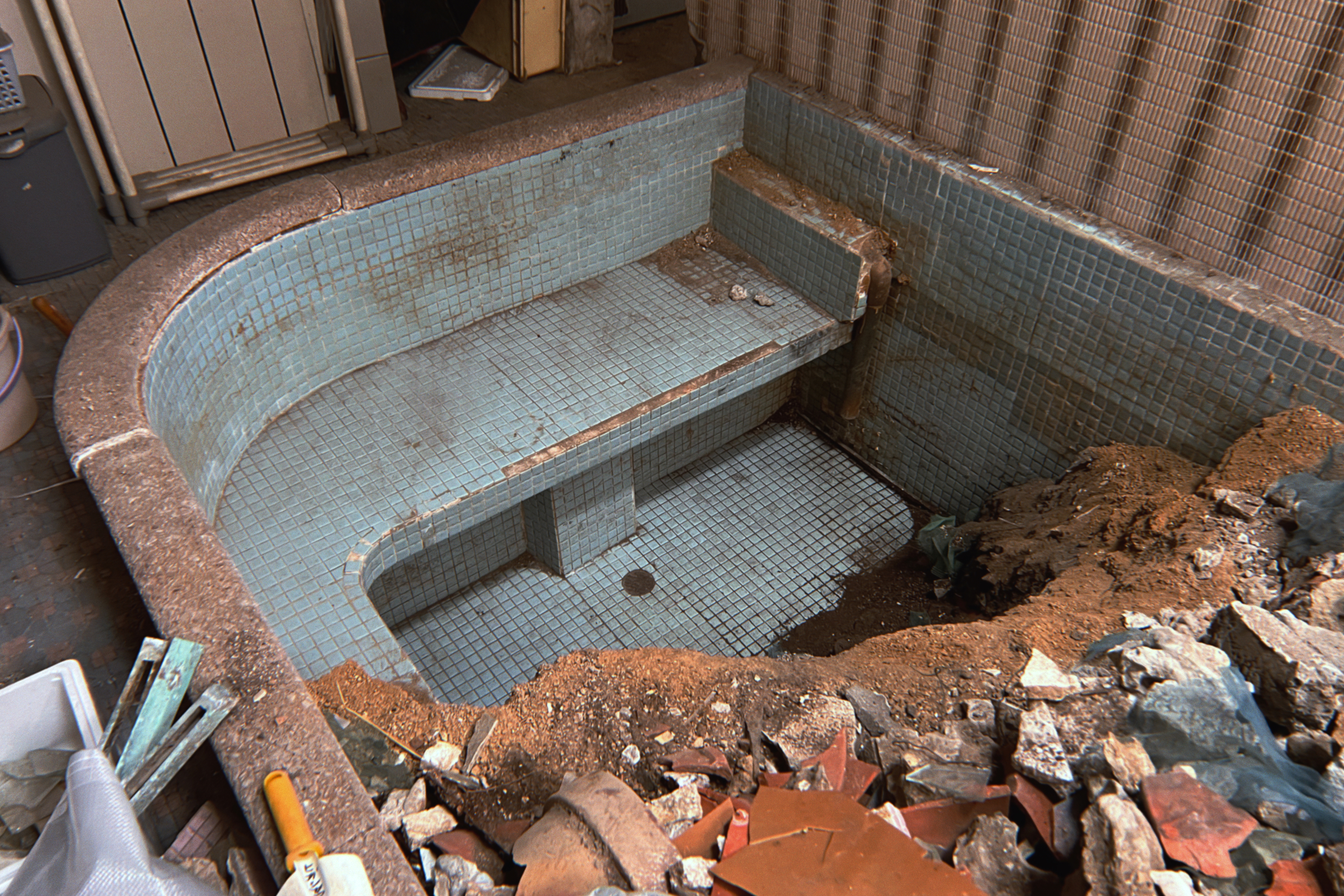2025
交互聲音裝置,多通道聲音系統,算法作曲,水泥塊,木盒,玻璃,陶瓷
Interactive sound installation, multichannel sound system, algorithmic composition, concrete blocks, wooden boxes, glass, ceramic
Documentary ✴︎ YouTube / Bilibili
這是 mafmadmaf 在日本瀨戶內國際藝術祭 2025 的參展作品,展期為全年度包括春/夏/秋三季。以下是他的自述,文本以單張印刷品呈現,觀眾可於藝術祭展期宇野港錢湯空間(un17)內取閱。
在玉野市附近的常山上,我順著導覽員北村先生手指的方向,望向填海區,開始想象從腳下的常山直到最遠處的海角之間曾經是藍色的海洋,現在已經是一整片規劃整齊,公路鐵路縱橫貫穿的黃綠相間的田野。在衛星圖上俯瞰岡山沿海那密密麻麻的小長方形,竟與舊港湯(宇野港口錢湯)內牆上的小瓷片格外相似;而同樣以水為源的舊港湯的湯船,也曾因為用途的改變而被填平。現在我們所站立的這個已被改造為作品的空間,錢湯內外所經歷的變遷在某層面上如出一轍。
 已成歷史的舊港湯,曾經氤氳、濕滑,這讓我不自覺地聯想起家鄉廣州的一種極端潮濕氣候,它被叫做「回南天」或者「返潮」—— 當春天溫暖的空氣在冰冷的表面結出大量水珠並順著牆面滴落地面。我想在破舊的舊港湯裡嘗試運用霧氣和水滴去驅動一次演奏。大量的霧氣累計到一定程度便產生水滴,不同位置和不同速度滴落的水滴激發電腦程序,生成後續所有我們能聽到的聲響。霧氣、水滴、聲音,三者依序誕生、也依序消失。
已成歷史的舊港湯,曾經氤氳、濕滑,這讓我不自覺地聯想起家鄉廣州的一種極端潮濕氣候,它被叫做「回南天」或者「返潮」—— 當春天溫暖的空氣在冰冷的表面結出大量水珠並順著牆面滴落地面。我想在破舊的舊港湯裡嘗試運用霧氣和水滴去驅動一次演奏。大量的霧氣累計到一定程度便產生水滴,不同位置和不同速度滴落的水滴激發電腦程序,生成後續所有我們能聽到的聲響。霧氣、水滴、聲音,三者依序誕生、也依序消失。
水是整個裝置的源頭。
我們不妨嘗試用手去接住下落的水滴,這樣便會如蝴蝶效應般改變後續程序的聲音生成 —— 一個超現實的、試圖觸及回憶深處的多聲道電子聲音景觀。作品在這兒呈現這種極端潮濕的狀態,不僅是某種異域與家鄉之間的聯結,亦是對舊港湯曾經風貌的部分還原:包括我們收集的錢湯老物件、重新挖開了湯船並展示了部分殘垣斷壁,皆意味著我們把部分原本存在於此的事物「物歸原主」。
關於命名,這時候不得不感嘆漢字一字多義的奧妙。「返潮」原本是這種極端潮濕氣候的名稱,當我們把兩個字拆開之後,各自又有了獨特的含義。「返」是「歸還、返還」之意,而「潮」除了「潮濕、潮氣」還有「海潮、浪潮」之意。宇野港 un17 這件作品《潮 返》正是得名於此。在人類蓬勃發展消耗極大量地球資源的時候,我們向天空、向土地、向海洋無窮盡地索取了遠超其負荷的能量,以滿足族群發展的眼前利益。這個作品試圖呈現出一個「逆行」的信號,返還那些原屬於這裡的事物和回憶。
—— 但願能把海潮返還予大海。
最後,要特別感謝在這次項目前期考察、準備和作品製作的過程中各位同仁和友鄰的支持,包括:Higashiyama-san, Mari-san, Shimooka-san, Man-san, Honma-san, Saito-san 等相關人士。
作品地點 ✴︎ Uno Port, un17
作品記錄 ✴︎ YouTube / Bilibili
This is mafmadmaf's work at the Setouchi Triennale 2025, presented throughout the entire year across the Spring, Summer, and Autumn. The following is his artist's statement, originally printed on a leaflet distributed to visitors at the Uno Port exhibition site (un17).
During a visit to Mount Tsuneyama, I followed the direction of our guide, Mr. Kitamura, and looked out over the expanse of reclaimed land. It was once a stretch of blue ocean, but is now a checkerboard of fields intersected by roads and railways. The transformation of the coastline — through land reclamation — spoke to a broader logic of erasure and repurposing. When viewed from above, the grid of reclaimed plots resembles the small ceramic tiles lining the walls of the former sento (Japanese public bathhouse). It struck me then that the very bathtubs inside had once also been filled — first with water, then, later, with concrete, then covered over, lost their original function and overwritten by time. This installation draws on that double gesture: the disappearance of water, and the memory it carries.
The humid atmosphere that once defined sento reminded me of "回南天," a seasonal phenomenon from my hometown Guangzhou, sometimes also called "返潮." When spring comes, warm air meets cold surfaces, causing water to condense and drip steadily down tiled walls. Here, I attempt to recreate that overwhelming moisture. Artificial mist slowly condenses into droplets, and their irregular falls are captured by sensors, which then trigger sound via a real-time computer algorithm. Mist, droplets, and sound unfold in cycles of approximately eight minutes, continuously appearing and disappearing. Visitors can catch the water drops with their hands — this simple act shifts the sonic output, subtly altering the experience for everyone who follows. It's a multichannel sound system of response, fragility, and reverberation.
The title Restitution of Tide draws on the layered meanings of the Chinese characters "返" and "潮," which refers both to the return of humidity in Spring and to the returning of sea waves. In an era marked by human's relentless extraction from the earth, this work gestures toward reversal: not to reconstruct the past, but to return something to where it came from — to allow the tide, at last, to return to the sea.
I am deeply grateful to all those who helped realize this work, including Higashiyama-san, Mari-san, Shimooka-san, Man-san, Honma-san, Saito-san, and many others.
Exhibit Location ✴︎ Uno Port, un17
Documentary ✴︎ YouTube / Bilibili

 ⌃ 與團隊攝于午餐後 With team after lunch.
↩︎ back to index
⌃ 與團隊攝于午餐後 With team after lunch.
↩︎ back to index